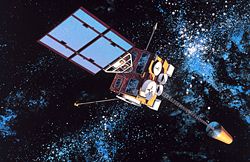| Designation | Launch Date/Time (UTC) | Rocket | Launch Site | Longitude | First Image | Status | Retirement | Remarks |
|---|
| Launch | Operational |
|---|
|
| GOES-A | GOES-1 | 16 October 1975, 22:40 | Delta 2914 | CCAFS LC-17A | | 25 October 1975 | Retired | 7 March 1985 [1] | |
| GOES-B | GOES-2 | 15 June 1977, 10:51 | Delta 2914 | CCAFS LC-17B | 60° W | | Retired | 1993 [2] | Reactivated as comsat in 1995, [2] finally deactivated in May 2001 |
| GOES-C | GOES-3 | 16 June 1978, 10:49 | Delta 2914 | CCAFS LC-17B | | | Retired | 1993 [3] | Reactivated as comsat in 1995, [3] decommissioned 29 June 2016 |
|
| GOES-D | GOES-4 | 9 September 1980, 22:57 | Delta 3914 | CCAFS LC-17A | 135° W | | Retired | 22 November 1988 [4] | |
| GOES-E | GOES-5 | 22 May 1981, 22:29 | Delta 3914 | CCAFS LC-17A | 75° W | | Retired | 18 July 1990 [5] | |
| GOES-F | GOES-6 | 28 April 1983, 22:26 | Delta 3914 | CCAFS LC-17A | 136° W [6] | | Retired | 21 January 1989 [6] | |
| GOES-G | N/A | 3 May 1986, 22:18 | Delta 3914 | CCAFS LC-17A | 135° W (planned) | N/A | Failed | +71 seconds | Launch failure [7] |
| GOES-H | GOES-7 | 26 February 1987, 23:05 | Delta 3914 | CCAFS LC-17A | 75° W, 98° W, 112° W, 135° W, 95° W, 175° W | | Retired | January 1996 [8] | Reactivated as comsat for Peacesat from 1999-2012, moved to graveyard orbit 12 April 2012. [9] |
|
| GOES-I | GOES-8 | 13 April 1994, 06:04 | Atlas I | CCAFS LC-36B | 75° W | 9 May 1994 | Retired | 4 May 2004 [10] | In graveyard orbit |
| GOES-J | GOES-9 | 23 May 1995, 05:52 | Atlas I | CCAFS LC-36B | 135° W, 155° E | 19 June 1995 | Retired | 14 June 2007 [11] | In graveyard orbit |
| GOES-K | GOES-10 | 25 April 1997, 05:49 | Atlas I | CCAFS LC-36B | 135° W, 65° W | 13 May 1997 | Retired | 1 December 2009 [12] | In graveyard orbit |
| GOES-L | GOES-11 | 3 May 2000, 07:07 | Atlas IIA | CCAFS SLC-36A | 135° W | 17 May 2000 | Retired | 16 December 2011 [13] [14] [15] | Retired, Drifting west |
| GOES-M | GOES-12 | 23 July 2001, 07:23 | Atlas IIA | CCAFS SLC-36A | 60° W | 17 August 2001 | Retired | 16 August 2013 | Operated at GOES-South covering South America, and retained as spare, following replacement at GOES-East by GOES-13. Now in a graveyard orbit. |
|
| GOES-N | GOES-13 | 24 May 2006, 22:11 | Delta IV-M+(4,2) | CCAFS SLC-37B | 75° W, 61.5° E | 22 June 2006 | Inactive | | Replaced by GOES-16 at GOES-East on 18 December 2017. [16] Operational again as EWS-G1 since 8 September 2020. |
| GOES-O | GOES-14 | 27 June 2009, 22:51 | Delta IV-M+(4,2) | CCAFS SLC-37B | 105° W | 27 July 2009 | Standby | | On-orbit spare, was used to cover GOES-East imagery and moved into position following GOES-13 malfunction in 2012, [17] also activated to cover GOES-13 outage in mid-2013 |
| GOES-P | GOES-15 | 4 March 2010, 23:57 | Delta IV-M+(4,2) | CCAFS SLC-37B | 61.7° E (Formerly 89.5° W, 135° W) | 7 April 2010 | Transferred [18] | | Transferred to United States Space Force for coverage over Indian Ocean as EWS-G2. |
| GOES-Q | NA | N/A | | | | | Not built | N/A | Planned but not contracted [19] |
|
| GOES-R | GOES-16 | 19 November 2016, 23:42 [20] | Atlas V 541 | CCAFS SLC-41 | 105° W (Formerly 75.2° W) | 15 January 2017 | Standby | | Former GOES-East, [16] [21] replaced by GOES-19 on 7 April 2025 |
| GOES-S | GOES-17 | 1 March 2018 [22] | Atlas V 541 | CCAFS SLC-41 | 89.5° W (Formerly 104.7° W, 137.2° W) | 13 November 2018 | Standby | | Former GOES-West, replaced by GOES-18 on 4 January 2023 |
| GOES-T | GOES-18 | 1 March 2022 21:38 [23] | Atlas V 541 | CCSFS SLC-41 | 137.2° W | | Active | | GOES-West |
| GOES-U | GOES-19 | 25 June 2024 [24] | Falcon Heavy | KSC LC-39A | 75.2°W [25] | 7 April 2025 | Active | | GOES-East |
|







